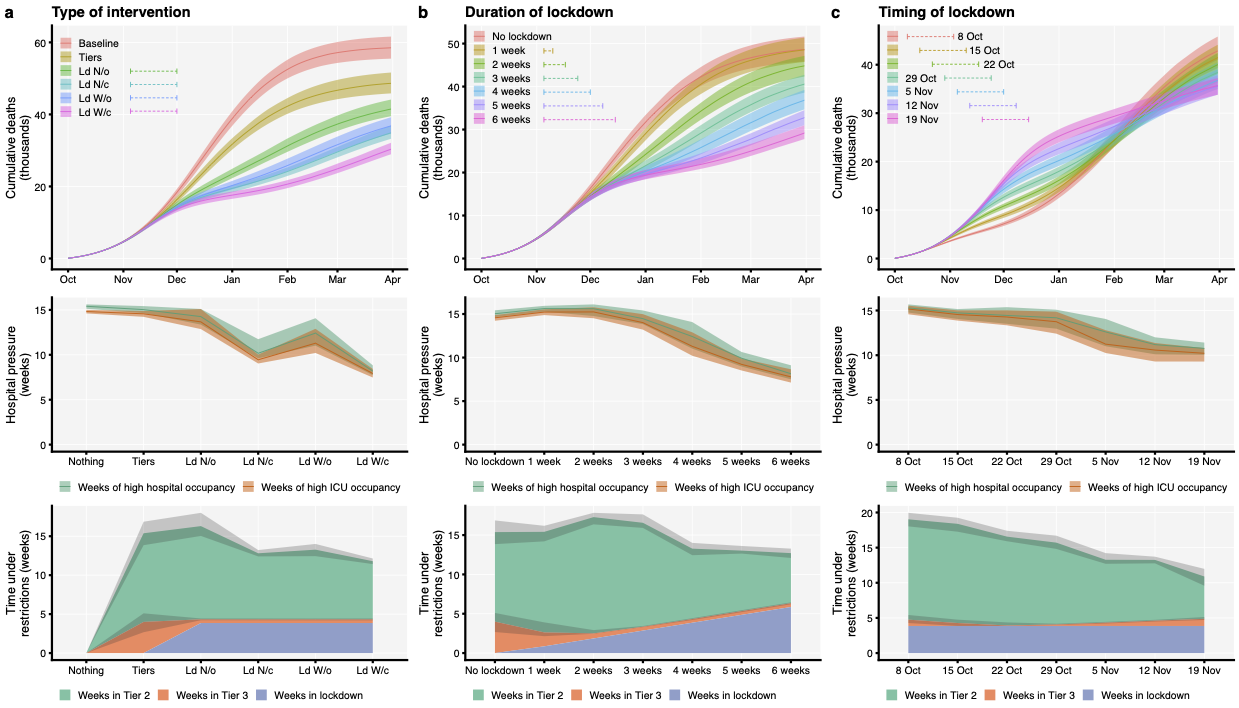Assessment of tiered restrictions and a second lockdown on COVID-19 deaths and hospitalisations in England: a modelling study
This manuscript has now been published in The Lancet Infectious Diseases.
We have archived the original report submitted to UK policymakers on Saturday, October 31 here.
A second wave of COVID-19 cases in Autumn 2020 led to localised, tiered “Alert Level” restrictions and subsequently a second national lockdown in England. We examine the impact of these tiered restrictions and alternatives for lockdown stringency, timing and duration.

Figure. Contrasting alternative intervention strategies. (a) Type of intervention: baseline epidemic without intervention (Baseline), tiered restrictions only (Tiers), Northern Ireland-type lockdown with schools open (Ld N/o) or with schools closed (Ld N/c), Wales-type lockdown with schools open (Ld W/o) or closed (Ld W/c). Note that the lines for Ld N/c and Ld W/o closely overlap in the top row. (b) Duration of lockdown: with tiered restrictions in place, commencing on 5 November 2020, Wales-type lockdowns with schools open with durations from 0 weeks (No lockdown) to 6 weeks are contrasted. (c) Timing of lockdown: four-week Wales-type lockdowns with schools open starting up to four weeks before or two weeks after 5 November 2020 are contrasted. Top row shows cumulative deaths over time under each scenario. Middle row shows hospital pressure, defined as the population-weighted average number of weeks that an NHS region’s hospital (green) or ICU (orange) bed occupancy exceeds 50% of the peak occupancy for that region during the first wave of COVID-19 in England. Bottom row shows the expected number of weeks that a random individual in England spends under Tier 2, Tier 3, or lockdown restrictions for each scenario. All panels show medians with shaded regions defining 95% confidence intervals.
Methods We fit an age-structured mathematical model of SARS-CoV-2 transmission to hospital admissions and occupancy (ISARIC4C/CO-CIN, NHS England), seroprevalence (ONS, UK Biobank, REACT-2 study), virology (REACT-1 study) and death data (Public Health England) across seven NHS England regions from 1 March – 13 October 2020. We analyse mobility (Google Community Mobility) and social contact (CoMix study) data to estimate the effect of tiered restrictions in England, and of lockdowns implemented in Northern Ireland and Wales in October 2020, and project epidemiological scenarios for England to 31 March 2021.
Findings We estimated a reduction in the effective reproduction number Rt of 2% (95% confidence interval: 0–4%) for tier 2, 10% (6–14%) for tier 3, 35% (30–41%) for a Northern Ireland-stringency lockdown and 44% (37–49%) for a Wales-stringency lockdown. From 1 October 2020 to 31 March 2021, a projected COVID-19 epidemic without tiered restrictions or lockdown results in 280,000 (274,000–287,000) hospital admissions and 58,500 (55,800–61,100) deaths. Tiered restrictions reduce burdens to 238,000 (231,000–245,000) hospital admissions and 48,600 (46,400–50,700) deaths. From 5 November 2020, a four-week Wales-type lockdown with schools open—similar to lockdown measures announced in England—was projected to further reduce the burden to 186,000 (179,000–193,000) hospital admissions and 36,800 (34,900–38,800) deaths. Closing schools further reduces deaths to 30,300 (29,000 - 31,900). A projected lockdown of greater than 4 weeks reduces deaths, but brings diminishing returns in reducing peak pressure on hospital services. An earlier lockdown reduces deaths and hospitalisations in the short term, but leads to a faster resurgence in cases after January 2021.
Interpretation Lockdown measures outperform less stringent restrictions in reducing cumulative deaths. The policy adopted in England reduces pressure on the health service, is well-timed to suppress deaths over the winter period, and keeps schools open. Following completion of the analysis, we analysed new data from November 2020, and found that despite similarities in policy, the second lockdown in England had a smaller impact on behaviour than the second lockdown in Wales.
Read the full pre-print here, or the published article at The Lancet Infectious Diseases.